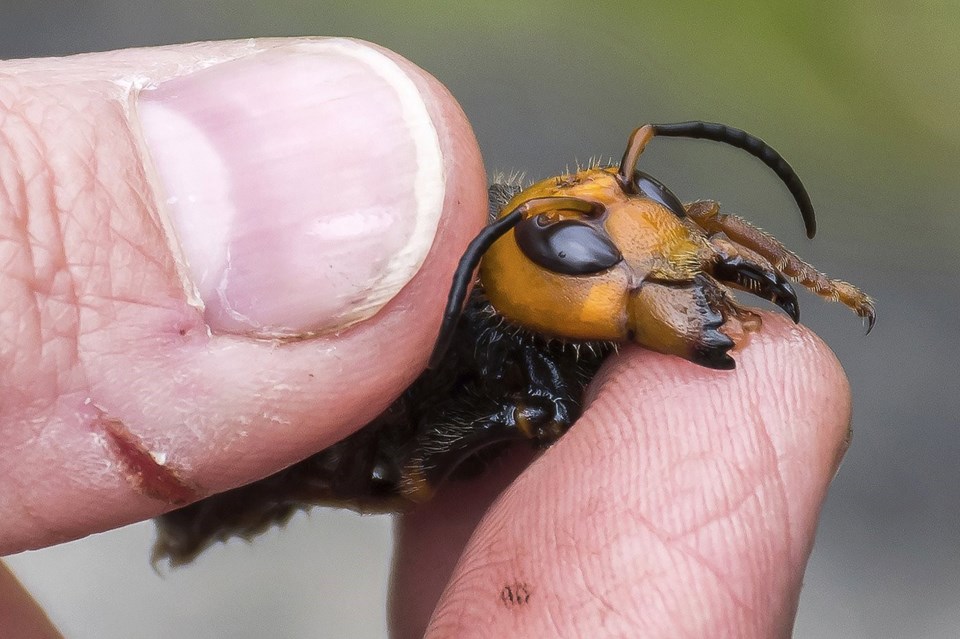A large, non-indigenous species of hornet that has been identified in Washington State and southern B.C. may have been spotted in Terrace.
On Sept. 29, Skeena Valley Apiary posted on Facebook that it had received a call from an individual claiming to have seen an Asian giant hornet, colloquially known as ‘murder hornets.’
Rudi Peters at the Skeena Valley Apiary said he usually would not give too much credibility to such a report, but was forced to based on who the tip came from.
“I’ve known him for years, he’s a member of the medical community here so he’s not prone to hysteria,” said Peters, in an interview with The Terrace Standard.
“If people do see these things they are unmistakable in their size, they are over two inches in size, these are not small creatures.”
Asian giant hornets have stingers long enough to puncture thick gloves and beekeeping clothing, sharp mandibles and toxic venom — multiple stings can be fatal.
“One or two stings may not kill you but you will want to wish you were dead, apparently the pain is something else,” said Peters.
A 2019 B.C. Ministry of Agriculture press release warned that people who are stung 10 times or more are at risk of developing toxic or allergic reactions, which can include dizziness. If this occurs, seek immediate medical help, the ministry said.
In Sept. 2019, officials confirmed the first-ever sightings of the species on Vancouver Island in the Nanaimo area. That was followed by additional sightings near Blaine, Wash. The species is native to regions in China, Korea, Japan and northern India.
Peters said provincial government apiarist Paul van Westendorp told him container ports and cargo ships are likely the main way the species enters North America, where scientists and researchers are scrambling to stop them from becoming entrenched.
‘Murder hornets’ can wreak havoc on European honeybee hives, the type of honeybee found in North America. According to the Washington State Department of Agriculture, only a few hornets can destroy entire hives in a few hours. In the fall, the hornets enter a “slaughter phase,” where they aggressively rampage, hunting and decapitating bees.
“These things are pretty much the Sherman tanks of the insect world, European honeybees have no defence against them, it’s like a fifth grader going up against an NFL linebacker, good luck,” said Peters.
“If it happens to come across a hive of honeybees, well, it’s an all-you-can-eat buffet, and so they are not going to pass that up.”
Honeybees in North America have never encountered Asian giant hornets before, so they have no defense mechanism and are helpless. The same cannot be said about Japanese honeybees, who naturally live in the same area as their much larger and stronger enemies. Those bees have found a way to turn up the heat on Asian giant hornets.
“The Japanese honeybees have a really cool defense against these things, and they kinda sucker them into the hive and then they basically ball them, they tackle them and then they start vibrating their wing muscles to generate heat,” said Peters.
“The survivable temperature difference between the hornet and the Japanese honeybees is three degrees Celsius so they literally roast the bugger.”
Asian giant hornets could conceivably survive in Terrace despite cold winter weather. They are dormant in the winter, and set up nests in the summer. But even if there is an Asian giant hornet in Terrace — the sighting is unconfirmed — it would need a specific set of conditions to be able to reproduce.
Peters said if there were a few lone workers or drones the risk of the species becoming established around Terrace is low, the problem is when a fertilized queen enters the area, which is what happened on Vancouver Island. That nest was destroyed.
Peters pointed out that aside from the slowdown caused by the COVID-19 pandemic, there is more movement and shipping around the world than ever before, increasing the chances of hornets hitching a ride across the Pacific.
“I just simply see it as a point of when, unless we are very conscious and very proactive in hunting these things out, they can get established on this continent as well,” he said.
“It’s just something that we have to keep an eye on. When that time does come where we have actual physical bodies that we can start finding we’ll just have to literally hunt them down and try and eradicate the nests.”
The provincial government advises people who may have seen an Asian giant hornet report their findings to the Invasive Species Council of BC at 1-888-933-3722, the council’s “Report Invasives” mobile app or at https://bcinvasives.ca/report



